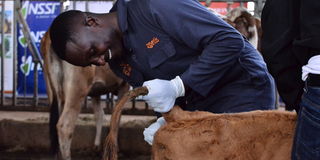Guard against diarrhoea in calves

Dr Brian Arinaitwe takes a swab on a calf to determine whether it has diarrhoea. PHOTO/George Katongole
What you need to know:
Calf diarrhoea or scours, is one of the most stressful and costly diseases for vets and farmers to deal with. Diarrhoea can be mild leading to mortalities at times.
Diarrhoea or calf scour can be a major cause of poor growth and calf mortality in livestock. Diarrhoea in calves is characterised by the acute appearance of watery faeces.
According to Dr Brian Arinaitwe, a veterinarian with Zoetis, diarrhoea affects between up to 35 percent of suckling calves and is responsible for more than 50 per cent of pre-weaning losses.
While explaining about livestock diseases that need careful management during the 25th edition of the Seeds of Gold Farm Clinic at the National Livestock Resources Research Institute (NaLIRRI) in Namulonge, Dr Arinaitwe said that diarrhoea causes loss of appetite and can reduce the average daily weight gain. Zoetis, a global animal health company, are partners of the Seeds of Gold Farm Clinic.
“Diarrhoea in calves causes serious economic losses. It can be reduced with adequate prevention and treatment,” Dr Arinaitwe says.
In a natural setting, calves suckle their mothers for up to a year. The incidence of diarrhoea is highly dependent on the level of colostral protection that a calf receives within the first six hours of life. It is generally recommended that calves receive three litres within the first two hours of life. However in commercial dairy farming, calves are taken away from their mother within hours of birth for sale or to be reared for beef.
According to Dr Arinaitwe this causes severe pain to both the cow and the calf leading to diseases.
He explains that if calf diarrhoea becomes a problem on the farm, the starting point is to check their immune status with a simple blood test. He recommends that the test is carried out by a veterinary doctor.
Causes
Dr Arinaitwe says diarrhoea is caused by viral infections including rotavirus. Calves are most commonly affected at eight to 14 days of age when there is an acute onset of diarrhoea, excreting very watery yellow/green faeces.
The infection is most times acquired from the calving accommodation and then spread between young calves in the herd through contact. Early signs include a reluctance to stand and drink, mild depression, and salivation. The calf becomes dehydrated with sunken eyes and tight and inelastic skin.
To manage the condition, Dr Arinaitwe says the calf should be isolated in a dry, well-bedded pen. It should then be administered with Effydral tablets four to eight times a day. They are oral rehydration therapy to cure scours in calves.
Apart from rotavirus, outbreaks of coronavirus diarrhoea are more severe although it is less common.
The treatment and prevention of coronavirus infection is the same as for rotavirus. Calves aged one to three days old which manifest sudden onset of profuse yellow/white diarrhoea may be affected by E. coli.
Diarrhoea is also caused by Cryptosporidiosis, a zoonotic disease that can affect humans too. There is profuse yellow/green diarrhoea with a lot of mucus in it. Dehydration is mild but the calf rapidly loses condition over two to five days and has a dull, tucked-up appearance.
Dr Arinaitwe advises farmers to consult a veterinarian for a suggested treatment protocol. Salmonella can also cause severe diarrhoea and may result in death.
Dr Arinaitwe explains that diarrhoea can also affect adult cows. He says that cattle naturally graze on grasses as they require lots of fibre in their diet. However, dairy cows that produce high yields of milk require more nutrient-dense diets, so are fed more concentrates and less forages. He says this leads to a build-up of acids in the rumen which causes acidosis if occurring for prolonged periods each day. Cows with acidosis often have diarrhoea.
Vaccination
Dr Arinaitwe says as with all animal diseases, prevention is better than cure and an effective veterinary herd health plan is essential.
“Vaccines are available against the most important infectious causes of calf diarrhoea, but a prevention strategy will only work if calves receive adequate volumes of good-quality colostrum within a few hours of birth,” he says. Dr Arinaitwe says that vaccination of healthy cattle is highly recommended. Using the one shot Bovine Virus Diarrhea Vaccine, farmers can protect against diarrhoea, among other diseases. He says that calves need to be vaccinated before six months and be revaccinated after afterwards or at weaning.
Ultravac Scourshield vaccine can also be used for the vaccination of healthy pregnant cows and heifers as an aid in preventing diarrhoea in their calves caused by certain bacteria and viruses.
The primary vaccination should consist of two doses at least 3–9 weeks apart from pregnant cows, with the second dose given 2–6 weeks prior to calving. He says that annual boosters with a single dose are administered 2–6 weeks before each subsequent calving.
In case of treatment, calves can be administered with fluid therapy, which is the most effective treatment strategy. Antibiotics can also be used to control concurrent infections.
All Zoetis solutions are available through partnership with local distribution agents at Eram Uganda and in Container Village.
Vaccine
The primary vaccination should consist of two doses at least 3–9 weeks apart from pregnant cows, with the second dose given 2–6 weeks prior to calving.




